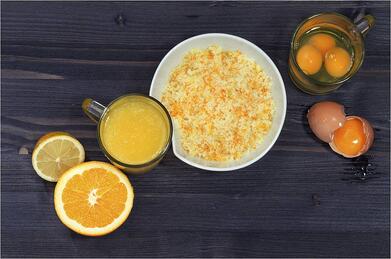Are you struggling with the winter time blues? Is it cold and dark and dreary in your part of the country? When was the last time you felt and saw the sun? You could be lacking Vitamin D and this can lead to depression and a lower immunity to fight colds. So, if you aren’t able to get your much needed 15 minutes of sunlight each day to acquire your body’s Vitamin D needs then here are some other ways to get it in until we have some sunshine in the spring!
- Fatty Fish – salmon, mackerel, canned tuna, and sardines. 3 oz of salmon provides 450 IU of
 Vitamin D…almost all of the 600 IU that are recommended daily. The canned tuna and sardines are an inexpensive way to get in seafood, heart healthy omega 3’s and 150 IU of Vitamin D per serving. Another bonus is the long shelf life if you haven’t been to the grocery store to get fresh protein choices.
Vitamin D…almost all of the 600 IU that are recommended daily. The canned tuna and sardines are an inexpensive way to get in seafood, heart healthy omega 3’s and 150 IU of Vitamin D per serving. Another bonus is the long shelf life if you haven’t been to the grocery store to get fresh protein choices. - Milk – Almost all cows’ milk in the US is fortified with Vitamin D. A lot of other dairy products are too, but not ice cream or cheese. Typically an 8 oz glass of milk has 100 IU’s of Vitamin D and most yogurt has around 80 IU for a 6 oz container. If you are choosing soymilk or almond milk, most are fortified but check the labels to be sure.
- Fortified Orange Juice – If you aren’t a fan of milk or have lactose intolerance, 100% orange juice is an option. Typically an 8 oz glass has the same amount of Vitamin D as a glass of milk (100 IU). Just make sure you are buying the fortified kind!
- Egg Yolks – Eggs are a great way to get in Vitamin D. However, you have to eat the whole egg and not just the whites to get the benefit. One egg yolk has 40 IU’s.
- Fortified Cereal – Another way to double up on Vitamin D is to choose a fortified cereal to have with your milk or glass of OJ at breakfast. 1 cup of Multi Grain Cheerios provides 90 IU’s of Vitamin D. Add that with the milk and you are close to 200 IU’s! Just be sure to choose cereals that are labeled fortified with Vitamin D.
- Supplements – If you still have trouble getting all of your Vitamin D needs met through food and the sun, an alternative is to take a supplement. The upper limit dose for individuals over age 9 is 4000 IU per day. Consuming more than this can lead to higher blood calcium levels and increased risk of kidney stones. Always talk to your physician before starting a supplement.
Recent studies have found that nearly 3 out of 4 individuals have either a Vitamin D deficiency or borderline deficiency. Most of this is due to the increase of being indoors compared to our parents and grandparents. Longer work hours, longer commutes in a vehicle, and more screen time indoors definitely plays a part. Get outside, incorporate more of the foods above, and chat with your doctor about supplementing. All of this can mean a healthier immune system, stronger bones, and lower risk of some cancers.
Follow us all month long via social media for tips from our registered dietitians using #NIFSNutrition!

 Vitamin D…almost all of the 600 IU that are recommended daily. The canned tuna and sardines are an inexpensive way to get in seafood, heart healthy omega 3’s and 150 IU of Vitamin D per serving. Another bonus is the long shelf life if you haven’t been to the grocery store to get fresh protein choices.
Vitamin D…almost all of the 600 IU that are recommended daily. The canned tuna and sardines are an inexpensive way to get in seafood, heart healthy omega 3’s and 150 IU of Vitamin D per serving. Another bonus is the long shelf life if you haven’t been to the grocery store to get fresh protein choices.